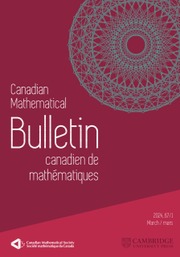Article contents
Nest Algebras of Operators and the Dunford-Pettis Property
Published online by Cambridge University Press: 20 November 2018
Abstract
A Banach space X is said to have the Dunford-Pettis Property if every weakly compact linear operator T: X —> Y, where Y is any Banach space, is completely continuous (that is, T maps weakly convergent sequences to strongly convergent ones). In this paper, we prove that if A is a nest algebra of operators on a separable, infinite dimensional Hilbert space, then A fails to have the Dunford-Pettis Property. We also investigate a certain algebra associated to A, analogous to a construction used by Bourgain and others in connection with the Dunford-Pettis Property for function algebras. We show that this algebra must lie between A and the quasi-triangular algebra A + K and we give examples to show that either extreme or something in between is possible. Finally, we consider the algebra of analytic Toeplitz operators and give a result for the corresponding associated algebra which is analogous to a result of Cima, Jansen, and Yale for H ∞.
Information
- Type
- Research Article
- Information
- Copyright
- Copyright © Canadian Mathematical Society 1991
References
- 1
- Cited by

